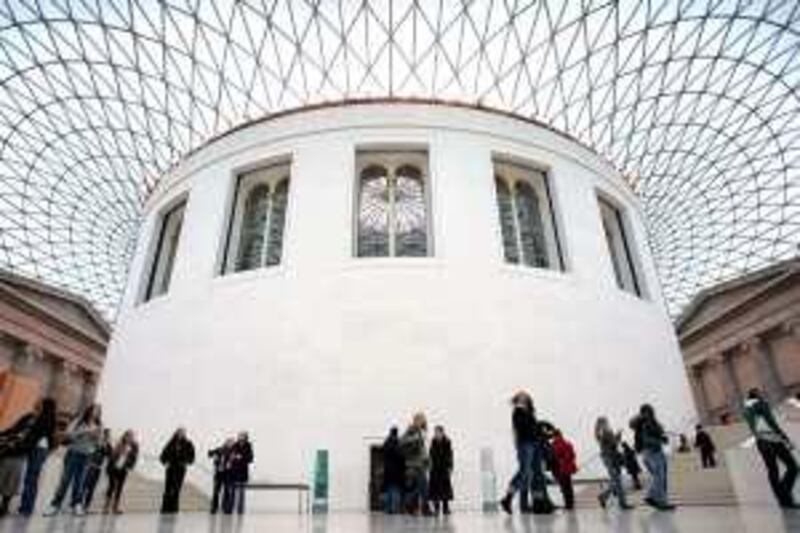ABU DHABI // It was described by its designer as an area of calm contemplation, but until now little was known about what shape the capital's museum in honour of the nation's founder would take. Yesterday the Tourism Development & Investment Company (TDIC) outlined what visitors can expect when the Zayed National Museum opens in Saadiyat Island's much-vaunted cultural district in 2013.
Due to be completed after the district's branch of the Louvre - which is scheduled to open in 2012 - but before its Frank Gehry-designed Guggenheim, the museum has set itself the ambitious goal of telling the story of the UAE through the prism of the values championed by Sheikh Zayed himself. "It will show Sheikh Zayed's initiatives were not only recognised in the UAE but in the region," said Mubarak al Muhairi, the TDIC's managing director. "The Zayed National Museum will be prominent, in the heart of the new cultural district.
To make these plans reality, the TDIC has enlisted the British Museum, which has signed a deal - also announced yesterday - to serve as a consulting partner on the project. Through a team split between the UAE and London, the British Museum will help to set up the new institute's governing body. It will advise on issues from design, construction and museography to educational and curatorial programming, as well as training.
Sheikh Sultan bin Tahnoon al Nahyan, chairman of the TDIC and of the Abu Dhabi Authority for Culture and Heritage, said: "The British Museum is a great and historic institution, known for its unsurpassed expertise in every field and its profound respect for every culture. "It will help us to make the Zayed National Museum a place of inspiration and pride for Emiratis, a beacon for the people of our region, and a source of information and understanding for our visitors from around the world."
The museum, which will cover an area of 12,000 square metres, is being designed by the London-based architects Foster + Partners, who won the contract in December 2007. Presenting his company's bid, Lord Norman Foster described plans for "an oasis - an area of calm in a bustling part of the Cultural District of Saadiyat Island". The architect, whose firm is also behind the Masdar City development, the Index building in Dubai, and the redevelopment of Abu Dhabi's central market, spoke then of the museum as "a national monument to values which will evoke an element of contemplation".
It will be composed of five permanent galleries under the themes of environment, heritage, unity, education and humanitarianism, with each of these themes applied in three dimensions: local, regional and international. For example, in the education gallery there will be the story of how Sheikh Zayed set up the UAE's first schools. Visitors will then be taken back to the story of Mesopotamia, ancient Greece and Egypt and how writing began.
Sheikh Zayed's environmental concerns will be traced back to show the interaction between humans and the landscape over many decades. The gallery will explore the physical landscapes, flora and fauna, and mineral resources of the UAE and the wider Middle East to show how people have shaped the environment, and how its resources have been exploited. The aim in the heritage section will be to show the common ties between desert civilisations, as well as the unique features that set the Gulf region apart from its Middle Eastern neighbours.
"Before society there was the story of the journey from the desert to the coast," said Mr al Muhairi. "If you study this you will have a good part of the history." The museum will focus on the common values once extolled by Sheikh Zayed. "He believed and supported the Islamic religion but focused on tolerance and was accepting to everyone. His values were universal," said Mr al Muhairi. The humanitarianism section will explore Islamic values in terms of how the nation developed. It will feature examples of communities living together and practising their own religions in freedom.
Similarly, the gallery for unity will focus on this but also on the political and cultural aspects of the Emirates and how they became united under Sheikh Zayed's guidance. Within this gallery there will be objects on display from archaeological sites across the region, which will be used to illuminate aspects of geography and of the region's ancient culture. Although specific details of exhibits are yet to be finalised, Mr al Muhairi said that with co-operation from the British Museum, a full inventory would be announced later this year.
"We are in the first phases of discussing which objects will be used to promote the five themes," he said. "One of the first tasks the specialised team from London will do is draw up a full list of everything we have." There will also be a schools programme. "We are living in an interesting era now," said Mr al Muhairi. "When I was a child there was nothing like the amount of education resources we have now and we want every young person to be able to make the most of it.
"There's nothing wrong with global recognition but I think we in the UAE will be benefiting most. "We hope the new museum will bring tolerance, acceptance and understanding to everyone through the story of a person who held these values most strongly." aseaman@thenational.ae






